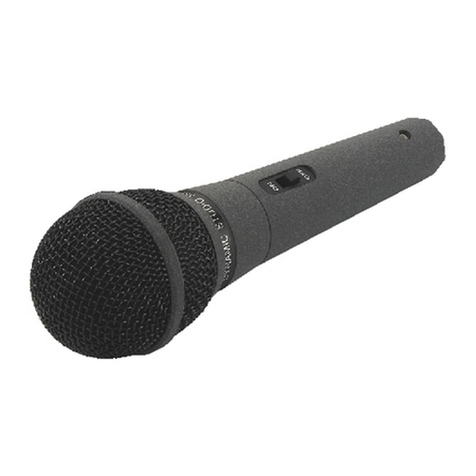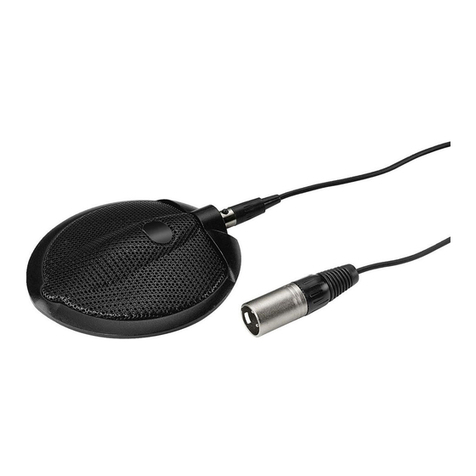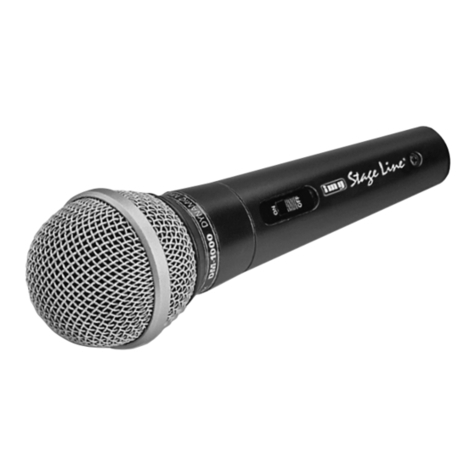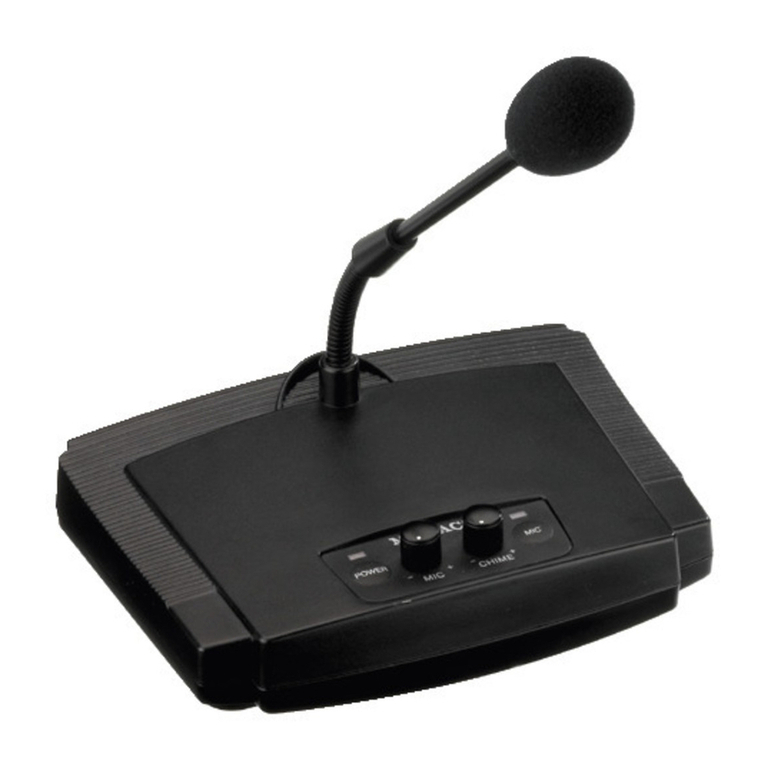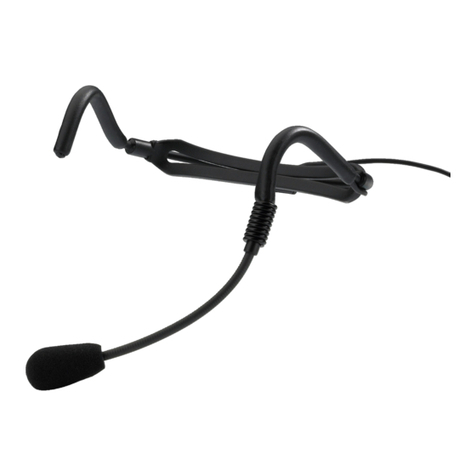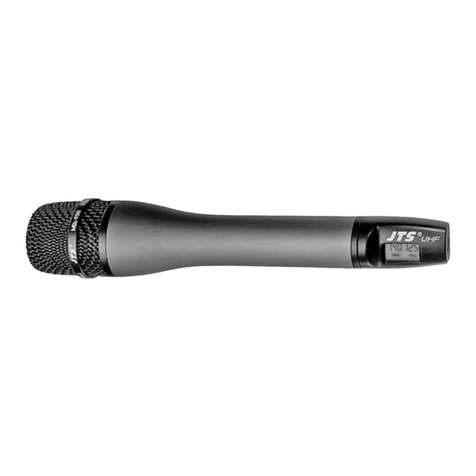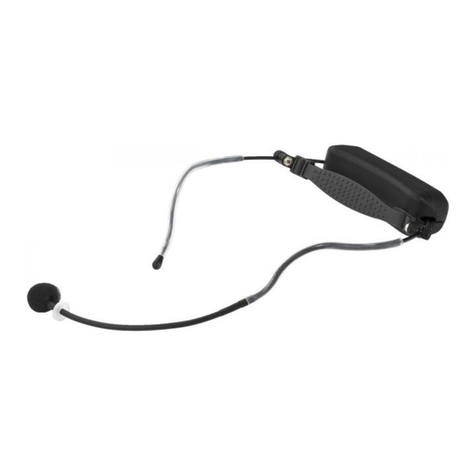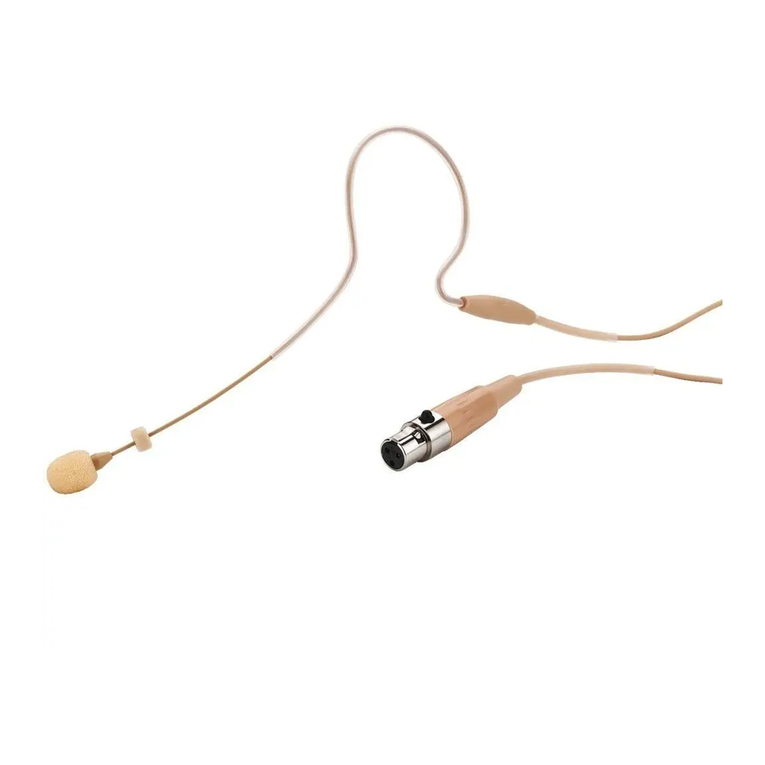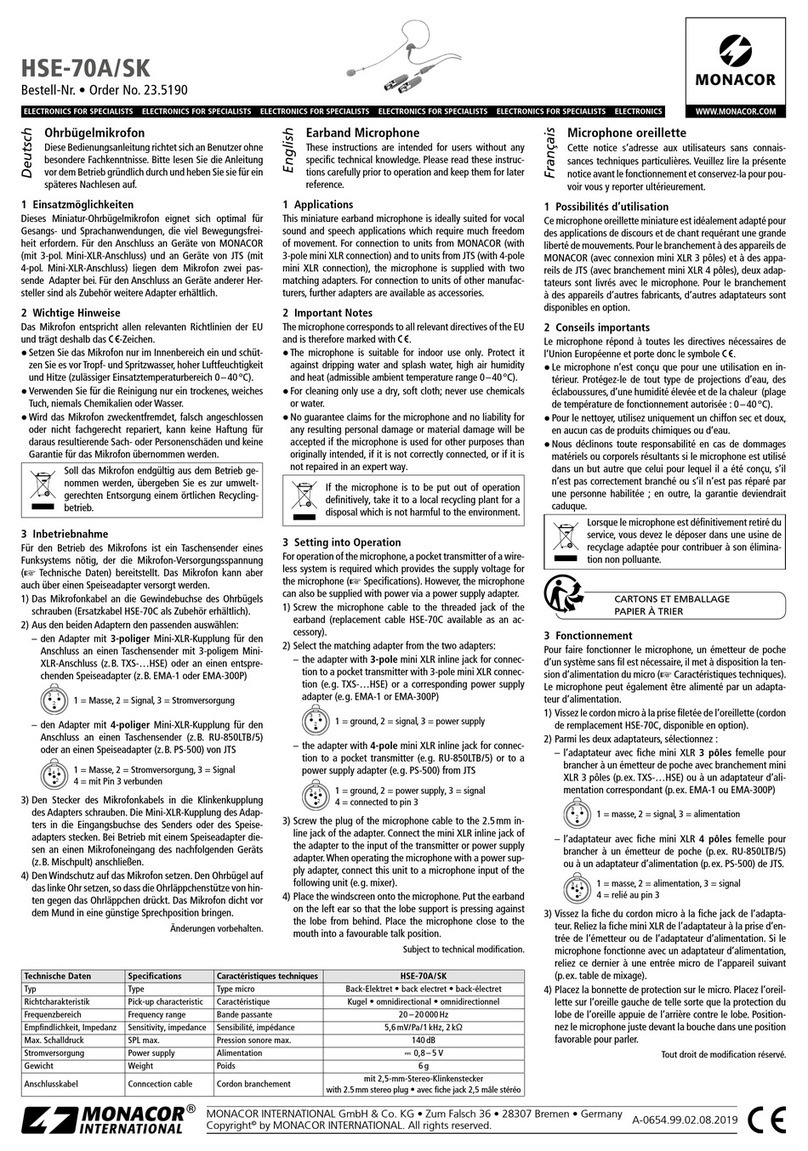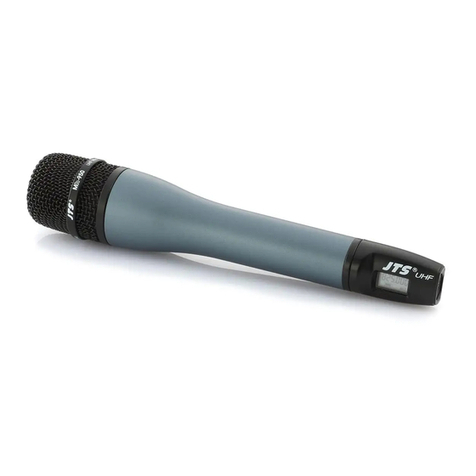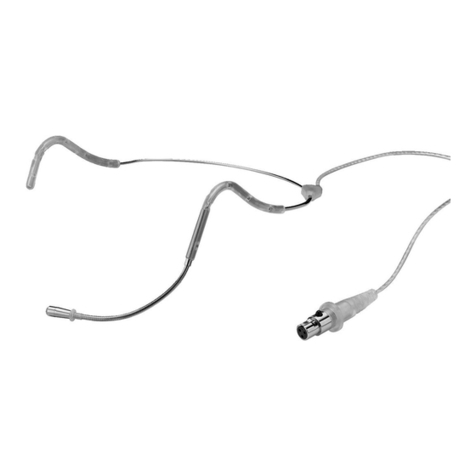
ELECTRONICS FOR SPECIALISTS ELECTRONICS FOR SPECIALISTS ELECTRONICS FOR SPECIALISTS ELECTRONICS FOR SPECIALISTS ELECTRONICS FOR SPECIALISTS ELECTRONICS
MONACOR INTERNATIONAL GmbH & Co. KG • Zum Falsch 36 • 28307 Bremen • Germany
Copyright©by MONACOR INTERNATIONAL. All rights reserved. A-0102.99.04.08.2016
12
3
20 Hz 50 100 200 500 1kHz 2 5 10 20 kHz
Front
Back
-
90 dB
-
80 dB
-
70 dB
-
60 dB
-
90 dB
-
80 dB
-
70 dB
-
60 dB
Microfono direttivo all’elettrete
Queste istruzioni sono rivolte all’utente senza
conoscenze tecniche specifiche. Vi preghiamo
di leggerle attentamente prima della messa in
funzione e di conservarle per un uso futuro.
1 Possibilità d’impiego
Il microfono ECM-925P con caratteristica direttiva
commutabile (a cardioide/a super cardioide) è parti-
colarmente indicato per registrazioni che richiedono
un forte effetto direzionale a causa dei rumori di
sottofondo. In dotazione sono un supporto per il
microfono, una cuffia antivento e un cavo low-noise
di 5metri. L’alimentazione è possibile, a scelta, attra-
verso un’alimentazione phantom 9– 48V (⎓) oppure
attraverso una batteria di 1,5V.
2 Avvertenze importanti per l’uso
Il microfono è conforme a tutte le direttive rilevanti
dell’UE e pertanto porta la sigla .
•
Proteggere il microfono dall’umidità e dal calore
(temperatura d’impiego ammessa fra 0°C e 40 °C).
Il microfono non è resistente alle intemperie. Nel
caso di riprese all’esterno proteggerlo dalla pioggia
e da altre precipitazioni.
•
Per la pulizia usare solo un panno morbido,
asciutto; non impiegare in nessun caso prodotti
chimici o acqua.
•
Nel caso d’uso improprio, di collegamenti sbagliati
o di riparazione non a regola d’arte del microfono,
non si assume nessuna responsabilità per eventuali
danni consequenziali a persone o a cose e non si
assume nessuna garanzia per il microfono.
Se si desidera eliminare il microfono defini-
tivamente, consegnarlo per lo smaltimento
ad un’istituzione locale per il riciclaggio.
Non gettare le batterie scariche nei rifiuti di casa
bensì negli appositi raccoglitori.
3 Messa in funzione
1) Se l’ingresso microfono previsto non è equipag-
giato con un’alimentazione phantom 9– 48V (⎓),
inserire una batteria del tipo mignon (AA), 1,5V.
Per fare ciò svitare la boccola alla parte inferiore
del microfono. Inserire la batteria come segnato
sul vano batteria.
Nel caso di non utilizzo prolungato, conviene
togliere la batteria per evitare che perda danneg-
giando il microfono.
2) Avvitare il supporto in dotazione su un treppiede
con filettatura di 16mm (5⁄8”) e posizionare il
microfono sul supporto. Se necessario applicare la
cuffia antivento.
3) Collegare il microfono con l’ingresso microfono
di un apparecchio audio (p.es. mixer, registratore,
amplificatore) servendosi del cavo in dotazione.
4) Selezionare la caratteristica direzionale con l’appo-
sito commutatore:
NORMAL = a cardioide, TELE = a super cardioide.
Il microfono è così acceso.
5) Se il microfono non serve più, spostare il commu-
tatore nella posizione inferiore. Il microfono così
è spento.
4 Dati tecnici
Banda passante: � � � � � � � � � 80 – 12 000 Hz
Sensibilità, impedenza
Normal (a cardioide):� � � � 3 mV/Pa a 1 kHz, 1,0kΩ
Tele (a super cardioide):� � 15 mV/ Pa a 1 kHz, 2,3 kΩ
Pressione sonora max�: � � � � 120 dB
Rapporto S/R: � � � � � � � � � � � > 40 dB
Alimentazione: � � � � � � � � � � alimentazione phantom
9 – 48V(⎓) oppure
batteria 1,5 V, mignon (AA)
Temperatura d’impiego:� � � � 0 – 40 °C
Corpo:� � � � � � � � � � � � � � � � � metallo
Dimensioni:� � � � � � � � � � � � � ⌀25 mm × 285mm
Peso senza batteria: � � � � � � 460 g
Collegamento:� � � � � � � � � � � XLR, sym�
Con riserva di modifiche tecniche.
ECM-925P
Référence num. •Codice. 23.1990
Microphone directionnel électret
Cette notice s’adresse aux utilisateurs sans
connaissances techniques particulières. Veuillez
lire la présente notice avec attention avant le
fonctionnement et conservez-la pour pouvoir
vous y reporter ultérieurement.
1 Possibilités d’utilisation
Le microphone ECM-925P commutable (cardioïde/
super cardioïde) est particulièrement bien adapté
pour les enregistrements, où une directivité impor-
tante est requise à cause de bruits parasites. Il est livré
avec un support micro, une bonnette anti-vent et un
cordon Low Noise de 5m de long. L’alimentation
peut être effectuée, au choix, via une batterie 1,5V
ou une alimentation fantôme 9– 48V (⎓).
2 Conseils importants d’utilisation
Le microphone répond à toutes les directives néces-
saires de l’Union européenne et porte donc le sym-
bole .
•
Protégez le microphone de l’humidité et de la chaleur
(température d’utilisation admissible 0–40°C). Le
microphone n’est pas résistant aux intempéries. Pour
cette raison, en cas des enregistrement extérieurs,
protégez-le de la pluie et d’autres précipitations.
•
Pour le nettoyer, utilisez un chiffon sec et doux, en
aucun cas de produits chimiques ou d’eau.
•
Nous déclinons toute responsabilité en cas de dom-
mages matériels ou corporels résultants si le micro-
phone est utilisé dans un but autre que celui pour
lequel il a été conçu, s’il n’est pas correctement
branché ou s’il n’est pas réparé par une personne
habilitée ; en outre, la garantie deviendrait caduque.
Lorsque le microphone est définitivement
retiré du service, vous devez le déposer
dans une usine de recyclage adaptée pour
contribuer à son élimination non polluante.
Ne jetez pas les batteries usagées dans la poubelle
domestique, ramenez-les à un container spécifique
(p.ex. un collecteur chez votre revendeur).
CARTONS ET EMBALLAGE
PAPIER À TRIER
3 Fonctionnement
1) Si l’entrée micro à laquelle le micro doit être relié
n’est pas dotée d’une alimentation fantôme
9– 48V (⎓), vous devez utiliser une batterie 1,5 V
de type AA (R6). Pour l’insérer, dévissez le cache
situé dans la partie inférieure du micro, placez la
batterie comme indiqué dans le compartiment.
En cas de non utilisation prolongée, veillez à
retirer la batterie du micro, elle pourrait couler et
l’endommager.
2) Vissez le support livré sur un pied avec un filetage
16mm (5⁄8”), et placez le micro dessus. Si besoin,
utilisez la bonnette livrée.
3) Reliez le micro via le cordon de branchement livré
à l’entrée micro d’un appareil audio (p.ex. table de
mixage, amplificateur, enregistreur).
4) Sélectionnez le type de fonctionnement avec le
potentiomètre à glissière :
NORMAL = cardioïde, TELE = super cardioïde
Le micro est alors allumé.
5) Pour l’éteindre en fin d’utilisation, poussez l’inter-
rupteur vers le bas.
4 Caractéristiques techniques
Bande passante :� � � � � � � � � 80 – 12 000 Hz
Sensibilité, impédance
normal (cardioïde) : � � � � � 3 mV/Pa à 1kHz, 1,0 kΩ
tele (super cardioïde) : � � � 15 mV/ Pa à 1 kHz, 2,3 kΩ
Pression sonore maximale : � 120 dB
Rapport signal/bruit : � � � � � > 40 dB
Alimentation : � � � � � � � � � � � alimentation fantôme
9 – 48V (⎓) ou
1 batterie 1,5V de type R6
Température d’utilisation :� � 0 – 40 °C
Corps : � � � � � � � � � � � � � � � � métallique
Dimensions : � � � � � � � � � � � � ⌀25 mm × 285 mm
Poids sans batterie : � � � � � � 460 g
Branchement :� � � � � � � � � � � XLR symétrique
Tout droit de modification réservé.
Italiano
Schéma électrique • Schema elettrico Réponse en fréquence • Risposta in frequenza Diagramme polaire • Diagramma direttivo
Français
